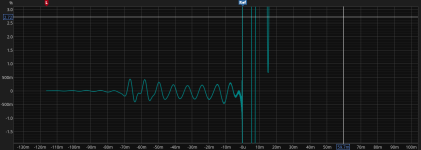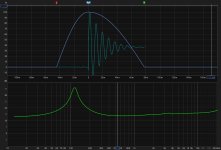@Daihedz
Many thanks for your diligent "detective" work! Interesting resonance behavior indeed. I have measured many different drivers, most of them from pro origin and none of them showed such resonance behavior - that is why I suspected error in measurements. Further investigation is needed...
Many thanks for your diligent "detective" work! Interesting resonance behavior indeed. I have measured many different drivers, most of them from pro origin and none of them showed such resonance behavior - that is why I suspected error in measurements. Further investigation is needed...
I count 6 ripples from 200-300Hz. That gives a ripple bandwidth of 16.666Hz. In order to create a comb response with this shape you need two single events that are 60ms apart in time. That comes to 67 feet through air!
Tight ripples like this are not physically possible without the associated time delay, and the same is true for frequency response charts. They are localized to 200Hz, which means that the interfering signal is also somewhat limited to 200Hz. If you plot the impulse response of the impedance all this becomes obvious. And of course there is the fact that he took a second measurement and it didn't show up.
So if the driver was sitting on a surface and the floor popped during the measurement the vibration could cause this. Another common cause of artefacts on the impedance chart is dropouts in the audio stream during the measurement. REW is more resistant to interference but other programs are more picky about noise and bumps in my experience.
If you export the impedance in .ZMA and open it as .FRD in REW, you can generate an impulse response which will show the aberration. Post the ZMA file and I will do it.
Tight ripples like this are not physically possible without the associated time delay, and the same is true for frequency response charts. They are localized to 200Hz, which means that the interfering signal is also somewhat limited to 200Hz. If you plot the impulse response of the impedance all this becomes obvious. And of course there is the fact that he took a second measurement and it didn't show up.
So if the driver was sitting on a surface and the floor popped during the measurement the vibration could cause this. Another common cause of artefacts on the impedance chart is dropouts in the audio stream during the measurement. REW is more resistant to interference but other programs are more picky about noise and bumps in my experience.
If you export the impedance in .ZMA and open it as .FRD in REW, you can generate an impulse response which will show the aberration. Post the ZMA file and I will do it.
Yeah, and any external sound is included there as well, you could sing while doing these impedance measurements and it's perfectly visible in the data, the driver is a mic while making impedance measurement. That said, if the 200-300Hz ripple is repeatable, it's weird thing, something within the driver I think.
An impulse response will go a long way to showing what it is, but the developers of measurement programs impresciently disallow viewing the impulse response of an impedance sweep.
the 200-300Hz ripple is repeatable, it's weird thing, something within the driver
Radial standing waves within an out-of-the-factory, relatively stiff, "non-broken-in" spider? Or a vibrational interaction of the surround and the spider (being compound by the cone, which at these frequencies might behave uniformly)?
If so, potentially any out-of-the-box driver might show a different pattern of impedance ripples than a sample already having intensively been "broken in".
By the way and speaking of breaking in a driver ... what may be the best signal for such cases? E.g. bandwidth filtered white noise between say f_res/2 and 5*f_res ? For how long and how intense? Some hours at an amplitude that makes the membrane move in it's full x_max range? I like continous filtered white noise, because it is acoustically less annoying than salvos of sine sweeps. And maybe it could be interesting to make two impedance measurements on future acquisitions to learn more about the benefits (or the non-benefit?) of breaking-in drivers: A first one, free air, driver right out-of-the box. Then, let's shake it, baby ... And then, a second measurement under an identical setup as the first one.
Therefore, maybe the 4FE42 may look smoother once it has been moved a bit.
Last edited:
Yeah hopefully it's some issue with suspension and goes away after workout / burnin.
You can stretch suspension by hand. Work it out both ways using your fingers, gently but firmly push the cone in /out as far as you dare. Hear how the glue and other stuff makes crackling noises, less so with each workout. Take occasional impedance sweeps to see how Fs drops, and stop until it doesn't 🙂
ps. not sure what your rig is, but I unhooked the driver to be sure there is no electrical damping when stretching this way. It's quite a weird thing do first tine, it takes surprising amount of power to do, and the cone seemed sturdy to widthstand it. Take easy at first and gradually go further if you dare 🙂
You can stretch suspension by hand. Work it out both ways using your fingers, gently but firmly push the cone in /out as far as you dare. Hear how the glue and other stuff makes crackling noises, less so with each workout. Take occasional impedance sweeps to see how Fs drops, and stop until it doesn't 🙂
ps. not sure what your rig is, but I unhooked the driver to be sure there is no electrical damping when stretching this way. It's quite a weird thing do first tine, it takes surprising amount of power to do, and the cone seemed sturdy to widthstand it. Take easy at first and gradually go further if you dare 🙂
Last edited:
I used to think that suspension resonances would smooth out with break in but when I started doing actual measurements of such things I never actually saw it. The closest I got is overdriving a tweeter and seeing Q went up permanently.
You can do an impedance sweep at multiple volume levels and compare the differences. You can do a quiet sweep, then a super loud sweep, then a quiet sweep again and compare the differences. Beyond the first hour or day or so of listening, measurable and relevant differences seem to end. Test amplitude changes the result more than break in does in my experience.
If the spider could reflect a movement with a delay of 60ms, then it would have a transmission line resonance of 16.6Hz, and multiples thereof. This would be very obvious and undesirable.
EDIT: For breaking in the suspension, A sine wave at Fs near xmax will give the largest spider flex with the least input power. But I like tmuikku's method better, you learn more doing it that way.
You can do an impedance sweep at multiple volume levels and compare the differences. You can do a quiet sweep, then a super loud sweep, then a quiet sweep again and compare the differences. Beyond the first hour or day or so of listening, measurable and relevant differences seem to end. Test amplitude changes the result more than break in does in my experience.
If the spider could reflect a movement with a delay of 60ms, then it would have a transmission line resonance of 16.6Hz, and multiples thereof. This would be very obvious and undesirable.
EDIT: For breaking in the suspension, A sine wave at Fs near xmax will give the largest spider flex with the least input power. But I like tmuikku's method better, you learn more doing it that way.
Okay there has been so many replies I won't answer them all here, but I'll take some new measurements and try to answer the most common ones.
4FE42_1 measured on table: __________________in hand:


4FE42_2 measured on table: _________________in hand:


And for clarification, some other drivers measured exactly the same way, a minute afterwards. (in hand and auto scale)
3FE22: _________________________________________Morel MW5:


Omnes SW5.01: _______________________________Panasonic 3" vented ht speaker:


As you can see, the measurement is not causing the peaks around 200Hz, it is the 4FE42 specifically, both of them.
The only other measurement with even a little similar artefacts is the SW5.01, which has maybe 2 bumps at 116Hz and 133Hz.
If you look closely, the ripples on the 4FE42 start to form at 145hz, then the peaks continue approx. at; 160, 175, 188, 204, 220, 236, 252, 268, 282, 297Hz,
so about 16Hz apart.
I have added the .zma file from the DATS sweeps of each 4FE42.
I always stretch the suspension of woofer style drivers to each maximum by hand before measurement, as I've noticed it does change the parameters.
4FE42_1 measured on table: __________________in hand:
4FE42_2 measured on table: _________________in hand:
And for clarification, some other drivers measured exactly the same way, a minute afterwards. (in hand and auto scale)
3FE22: _________________________________________Morel MW5:
Omnes SW5.01: _______________________________Panasonic 3" vented ht speaker:
As you can see, the measurement is not causing the peaks around 200Hz, it is the 4FE42 specifically, both of them.
The only other measurement with even a little similar artefacts is the SW5.01, which has maybe 2 bumps at 116Hz and 133Hz.
If you look closely, the ripples on the 4FE42 start to form at 145hz, then the peaks continue approx. at; 160, 175, 188, 204, 220, 236, 252, 268, 282, 297Hz,
so about 16Hz apart.
I have added the .zma file from the DATS sweeps of each 4FE42.
I always stretch the suspension of woofer style drivers to each maximum by hand before measurement, as I've noticed it does change the parameters.
Attachments
Last edited:
All but one speaker have some sort of ripple in the same frequency range. Yet this doesn't show up when anyone measures those speakers with another program.
When I convert the ZMA file to a .FRD file and generate the impulse response with REW, I am able to eliminate the ripples by windowing the impulse response.

Part of the ripple comes from 60ms before:

The rest comes from 80ms after:

As I said, such tight ripples are associated with a long wideband time delay, there is no mechanism in a 4" speaker which can cause this.
When I convert the ZMA file to a .FRD file and generate the impulse response with REW, I am able to eliminate the ripples by windowing the impulse response.
Part of the ripple comes from 60ms before:
The rest comes from 80ms after:
As I said, such tight ripples are associated with a long wideband time delay, there is no mechanism in a 4" speaker which can cause this.
Attachments
- Home
- Loudspeakers
- Full Range
- Any way to remove/reduce resonances in driver? (Faitalpro 4FE42)

